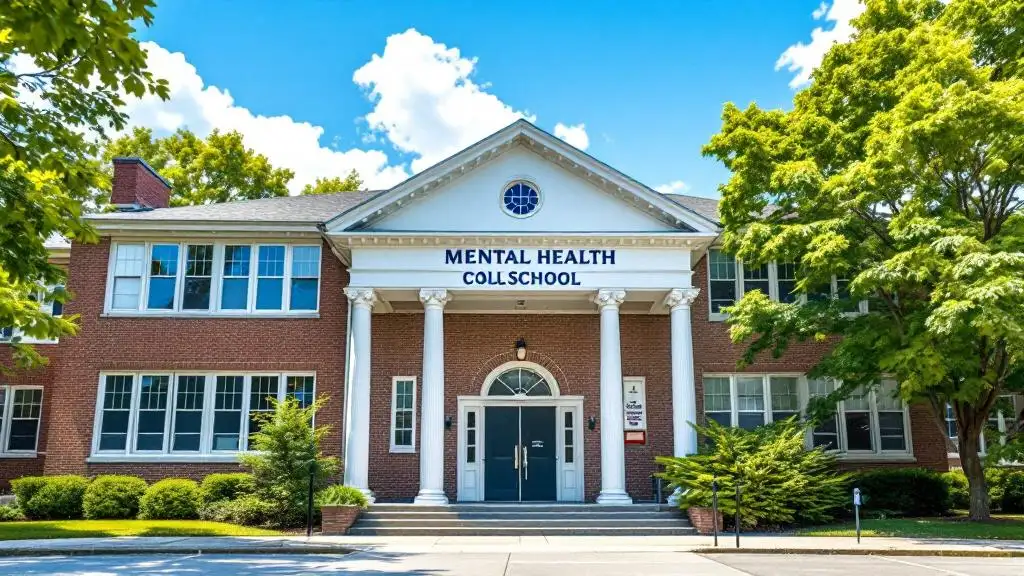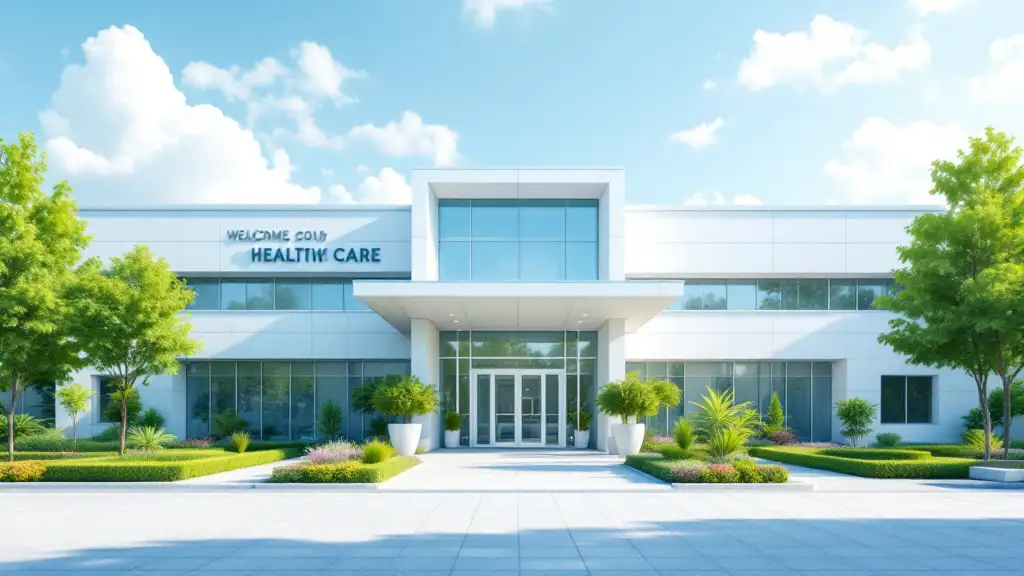Understanding and Overcoming Resistance for Better Outcomes
Therapy resistance remains a significant hurdle in adult cancer treatment, undermining the efficacy of conventional and targeted therapies. As tumors evolve through complex molecular, cellular, and microenvironmental mechanisms, a comprehensive understanding of these resistance pathways is crucial. This article explores the underpinning mechanisms of resistance, the role of cancer stem cells, genetic mutations, tumor microenvironment influences, and emerging therapeutic strategies aimed at overcoming these formidable barriers to improve patient prognosis.
Mechanisms of Therapy Resistance in Adult Cancers
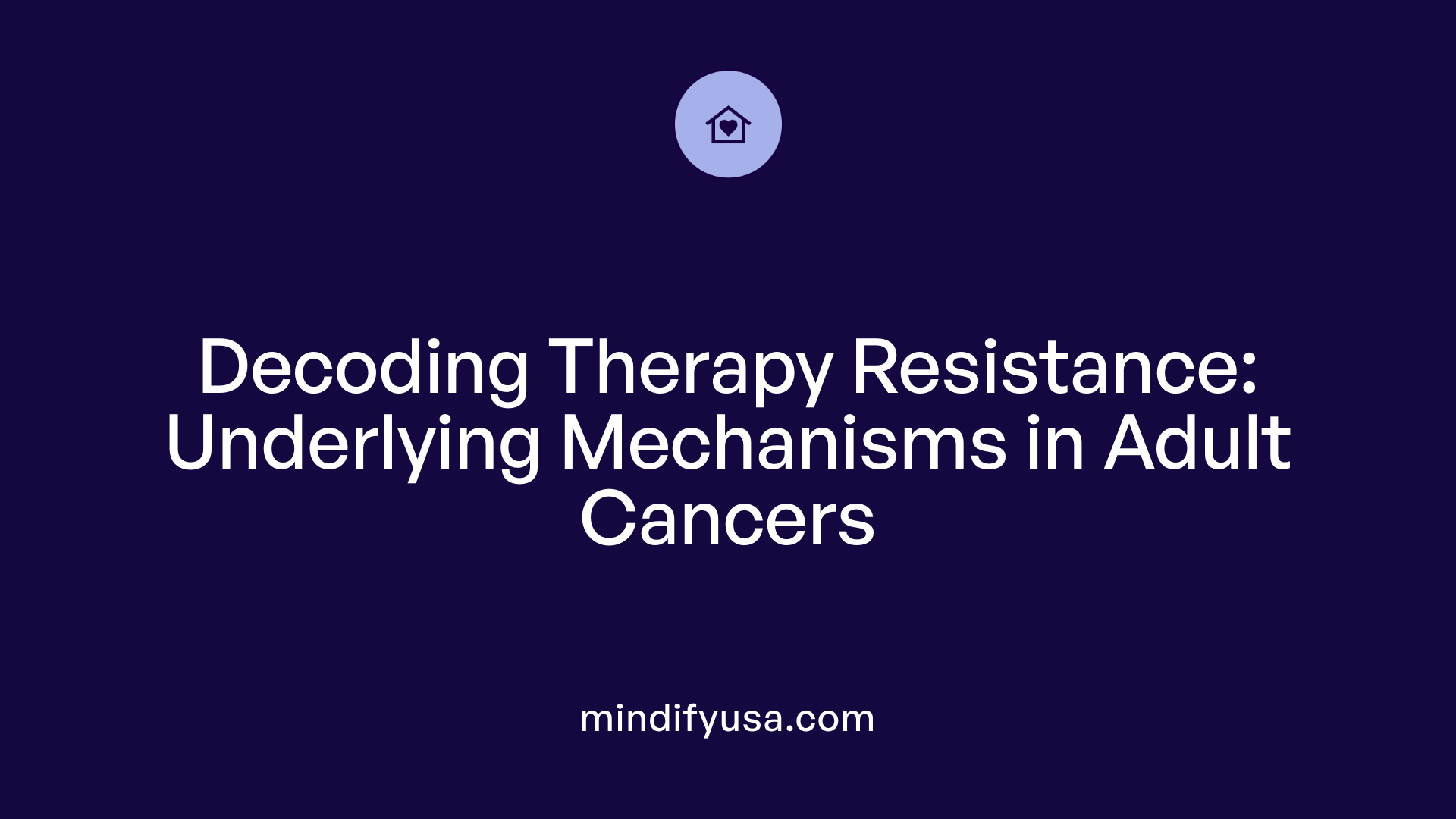
What are the mechanisms underlying therapy resistance in adult cancers, including molecular and cellular pathways?
Therapy resistance in adult cancers results from an intricate network of molecular and cellular processes that allow cancer cells to evade the effects of treatments. These mechanisms involve genetic mutations, epigenetic modifications, alterations in the tumor microenvironment (TME), and adaptive cellular behaviors.
One of the primary causes of resistance is genetic mutations that modify drug targets or activate bypass pathways. For example, secondary mutations in the EGFR gene in lung cancer can prevent tyrosine kinase inhibitors (TKIs) from binding effectively. Similarly, alterations like KRAS mutations or MET amplification can bypass the inhibited pathways, maintaining oncogenic signaling.
Epigenetic changes, such as DNA methylation and histone modifications, also play a role. These modifications can silence tumor suppressor genes or activate resistance-related genes, further reducing treatment efficacy. For instance, hypermethylation of certain tumor suppressor gene promoters can diminish apoptosis, contributing to drug resistance.
The tumor microenvironment is equally influential. Stromal cells, immune cells, extracellular matrix (ECM), and soluble factors collectively create a niche that shields tumor cells. Components like cancer-associated fibroblasts (CAFs) can produce cytokines and growth factors that promote survival signals or induce physical barriers, limiting drug penetration.
Drug inactivation and efflux are common resistance strategies. Enzymes such as cytochrome P450 can metabolize and inactivate chemotherapeutics. Efflux transporter proteins like ABCG2 and P-glycoprotein actively pump drugs out of cells, lowering intracellular drug concentrations and reducing effectiveness.
Alterations in DNA repair pathways are critical for resistance development. Overexpression of repair proteins like PARP can fix chemotherapy or radiation-induced DNA damage, enabling survival. Enhanced DNA repair capacity is often associated with resistance to alkylating agents and radiation therapy.
Cancer stem cells (CSCs) represent another barrier, harboring self-renewal and pluripotency features. These cells often exhibit intrinsic resistance due to high drug efflux activity, quiescence, and robust DNA repair. Pathways like Wnt/β-catenin, Notch, and Hedgehog regulate CSC maintenance and are frequently activated in resistant tumors.
Epithelial-mesenchymal transition (EMT), a process where epithelial cells gain mesenchymal traits, further facilitates resistance. EMT contributes to increased motility, invasiveness, and the acquisition of stem-like properties, making cells less responsive to conventional therapies.
Compensatory signaling through pathways such as TGF-β, NF-κB, and PI3K/Akt can reactivate growth and survival signals even when primary pathways are inhibited. This pathway reactivation underscores the importance of combination treatments targeting multiple nodes.
The interaction of tumor cells with exosomes and extracellular vesicles (EVs) can spread resistance factors between cells, promoting horizontal resistance transfer. These vesicles can carry drug-efflux proteins, microRNAs, and other molecules that modulate drug response.
Overall, overcoming therapy resistance requires strategies that address these diverse resistance mechanisms. Approaches include designing combination therapies to target multiple pathways, modulating the tumor microenvironment, and developing agents that specifically eliminate resistant CSC populations. An in-depth understanding of these resistance processes is vital for developing next-generation therapies and improving patient outcomes.
| Resistance Mechanism | Example | Role in Resistance | Potential Therapeutic Target |
|---|---|---|---|
| Genetic Mutations | EGFR T790M | Reduces drug binding affinity | Third-generation TKIs |
| Efflux Transporters | P-gp, ABCG2 | Pump drugs out of cells | Inhibitors of transporters |
| DNA Repair Enhancement | PARP overexpression | Repair damage from chemo/radiation | PARP inhibitors |
| Signaling Pathway Activation | Wnt/β-catenin, Notch | Promote survival and stemness | Pathway-specific inhibitors |
| Tumor Microenvironment | CAFs, ECM, hypoxia | Physical barrier, survival signals | Microenvironment-targeted therapies |
| Cancer Stem Cells | CD133+ cells | Quiescent, drug-resistant | CSC-specific agents |
| EMT Processes | E-cadherin loss | Increased motility, resistance | EMT inhibitors |
Addressing these resistance mechanisms with personalized and combination therapies holds promise for more effective and durable treatment responses in adult cancers.
Cancer Stem Cells: Key Mediators of Resistance
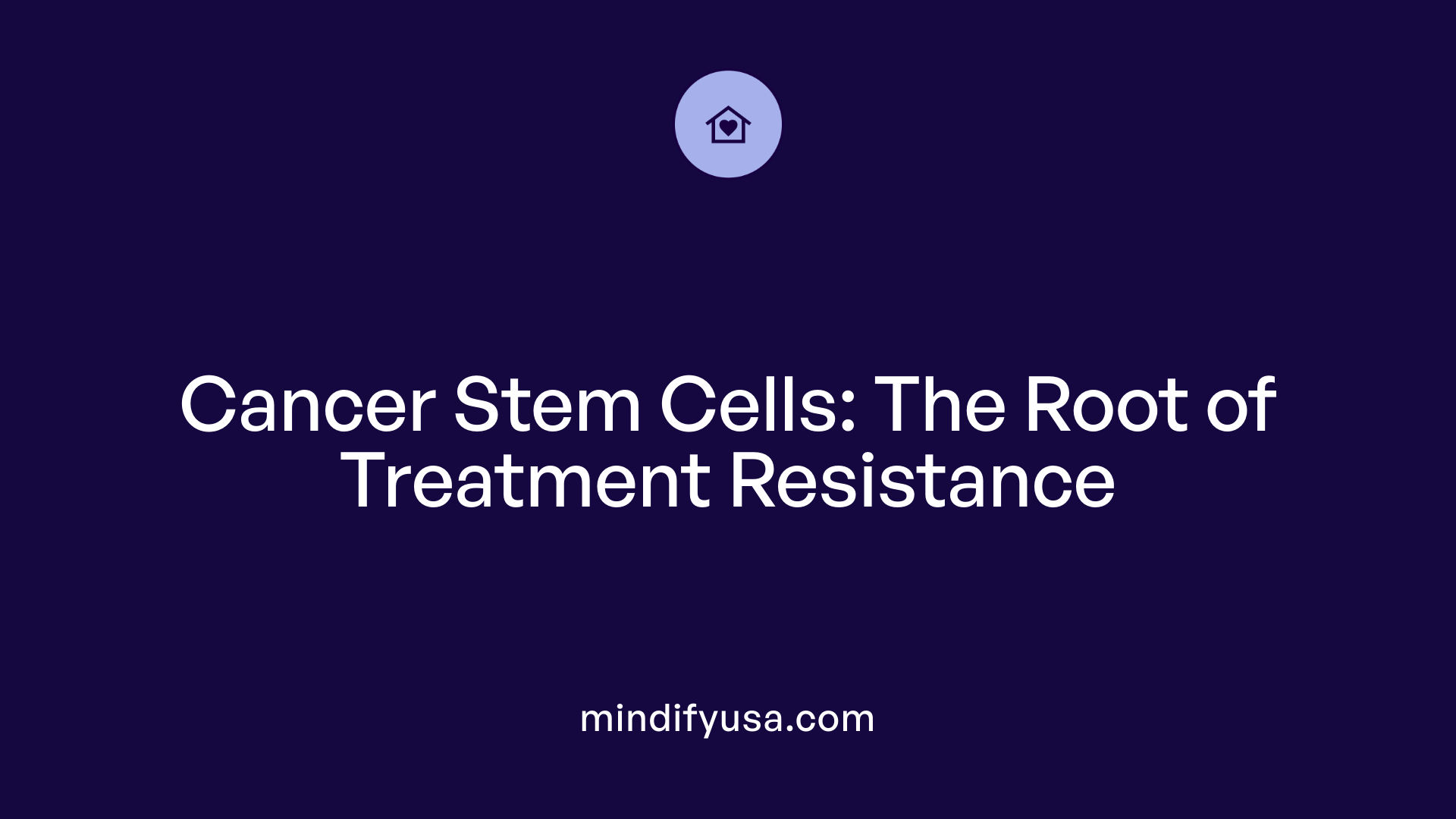
What role do cancer stem cells (CSCs) play in mediating therapy resistance, and how can they be identified?
Cancer stem cells (CSCs) are a small but significant population within tumors that have the ability to self-renew and differentiate into various cell types constituting the tumor. Their unique properties make them major contributors to therapy resistance. Because they can remain dormant or quiescent, CSCs survive conventional treatments like chemotherapy and radiotherapy that target rapidly dividing cells. Additionally, they possess robust DNA repair mechanisms and anti-apoptotic pathways, enabling them to evade cell death even under stress.
Identification of CSCs relies on specific surface markers and functional assays. Common surface markers include CD133, CD44, and ALDH1. For example, CD133 is widely expressed in many tumor types and correlates with poor prognosis and treatment resistance. Other markers such as CD166, CD49f, CD24, and CD9 are also associated with CSC properties and resistance.
Beyond surface markers, the activity of certain signaling pathways crucial for stemness and survival, like Wnt/β-catenin, Notch, Hedgehog, and Hippo/YAP, further characterize CSC populations. Elevated activity within these pathways promotes self-renewal and resistance to therapies.
How do CSCs contribute to therapy resistance?
Mechanisms behind CSC-driven resistance include increased drug efflux due to upregulated ABC transporter proteins, which actively pump out chemotherapeutic agents. They also undergo metabolic adaptations, such as altered redox states and enhanced DNA repair, which help withstand cellular damage.
Moreover, CSCs interact with their microenvironment, forming protective niches that provide growth factors and suppress immune responses. Epithelial-to-mesenchymal transition (EMT) programs endow CSCs with enhanced migratory and invasive capabilities, facilitating metastasis and resistance.
Survival strategies like dormancy allow CSCs to escape treatments targeting proliferating tumor cells. Once therapy ceases, these dormant cells can re-enter the cell cycle, leading to relapse.
Which signaling pathways are involved in maintaining CSC plasticity and resistance?
Several developmental and survival pathways are crucial for the maintenance and plasticity of CSCs. These include:
| Pathway | Role in CSCs and Resistance |
|---|---|
| Wnt/β-catenin | Promotes self-renewal and proliferation, linked to therapy resistance across multiple cancers |
| Notch | Regulates cell fate decisions and maintains stemness, contributing to therapy evasion |
| Hedgehog | Supports CSC maintenance, especially in basal cell carcinoma and gliomas |
| Hippo/YAP1 | Enhances tumor growth and survival, mediating resistance by upregulating EGFR and CDK6 |
| JAK/STAT | Facilitates inflammatory signaling and stemness |
Inhibiting these pathways with targeted agents holds promise in reducing CSC populations and overcoming resistance.
Strategies to target CSCs and counteract resistance
Current approaches focus on disrupting key signaling pathways, targeting surface markers, and modifying the tumor microenvironment. Examples include:
- Inhibitors of Wnt/β-catenin (e.g., PRI-724)
- Notch pathway inhibitors like gamma-secretase inhibitors (GSIs)
- Hedgehog pathway inhibitors such as Vismodegib
- YAP1 inhibitors like CA3
- Monoclonal antibodies targeting specific CSC surface markers (e.g., anti-CD133 therapies)
- Modulators of tumor microenvironment interactions, including immune checkpoint blockade and stromal modulation
Combining these strategies with conventional therapies may improve eradication of CSCs, reduce relapse, and enhance overall treatment efficacy.
This comprehensive approach to understanding and targeting CSCs offers a promising avenue to combat therapy resistance and improve cancer outcomes.
Genetic Mutations and Resistance: The Case of BRAF and EGFR T790M
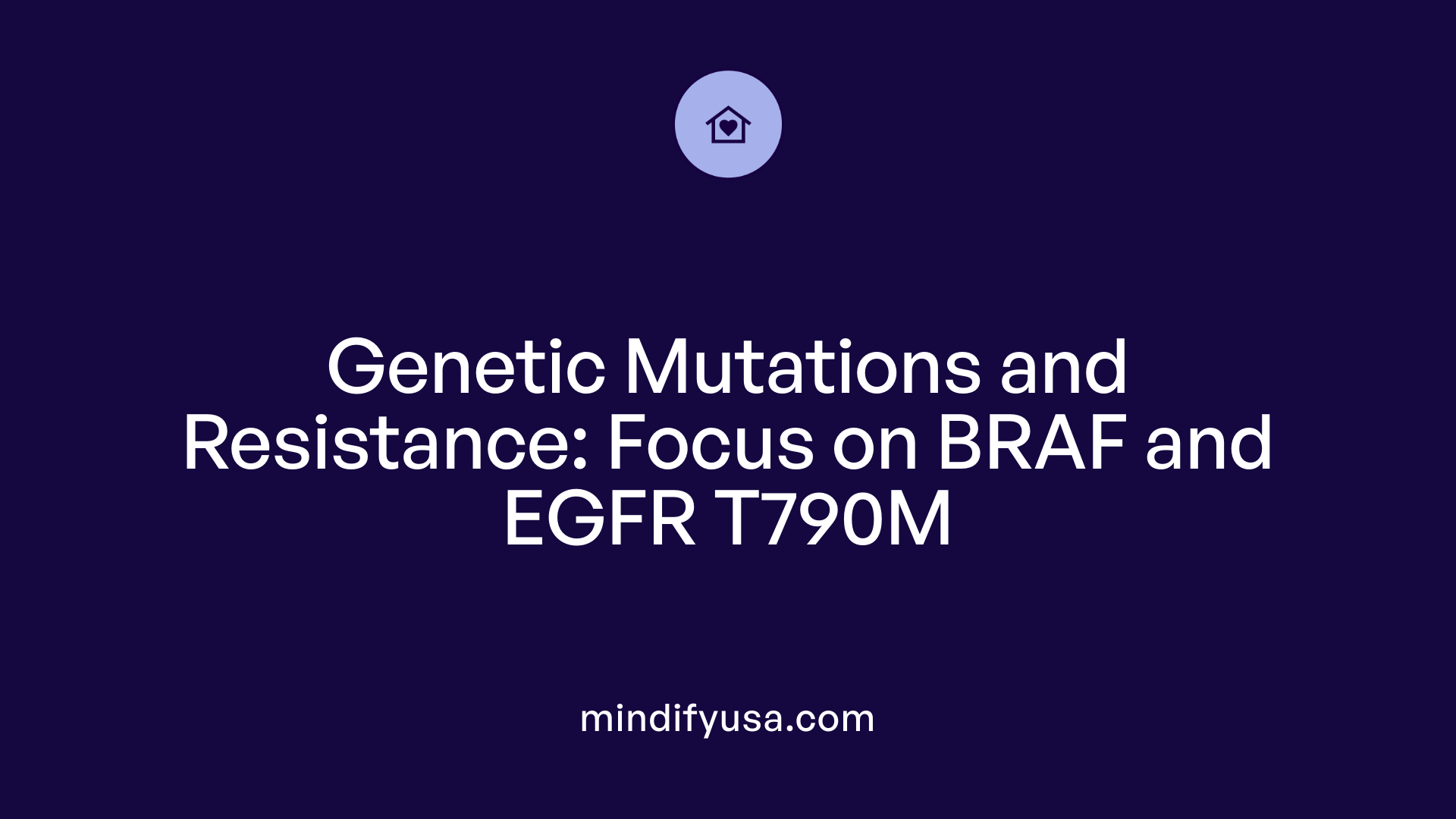
How are specific genetic mutations, such as BRAF or EGFR T790M, associated with acquired resistance, and what strategies exist to overcome these mutations?
Genetic mutations play a crucial role in the development of resistance to targeted cancer therapies. For example, in melanoma, mutations in the BRAF gene, particularly the V600E mutation, drive tumor growth and are initially sensitive to specific BRAF inhibitors. However, over time, tumor cells can acquire additional mutations or activate alternative pathways, leading to therapy resistance.
Similarly, in non-small cell lung cancer (NSCLC), the emergence of the EGFR T790M mutation is a common mechanism of acquired resistance to first- and second-generation EGFR tyrosine kinase inhibitors (TKIs). This mutation occurs at a gatekeeper residue, restoring the affinity for ATP and reducing the effectiveness of TKIs. As a result, tumors continue to grow despite ongoing targeted therapy.
| Mutation Type | Associated Cancer | Resistance Mechanism | Approaches to Overcome Resistance |
|---|---|---|---|
| BRAF V600E | Melanoma | Reactivation of MAPK pathway via secondary mutations or alternative pathways | Use of next-generation BRAF inhibitors, combination with MEK inhibitors, or immunotherapies |
| EGFR T790M | Lung Cancer | Increased ATP binding affinity, reducing inhibitor effectiveness | Development of third-generation EGFR inhibitors, such as osimertinib, which specifically target T790M, or combination therapies aimed at bypass pathways |
Targeted therapies have evolved to address these resistance mutations. For BRAF-mutant melanoma resistant to initial inhibitors, newer agents like encorafenib and binimetinib have shown promise in overcoming resistance. In NSCLC, osimertinib has become a standard treatment for T790M-positive tumors, effectively binding to the mutant receptor.
Monitoring for the emergence of resistance mutations is vital for personalized treatment adjustments. Molecular profiling techniques such as liquid biopsies measuring circulating tumor DNA (ctDNA) enable real-time detection of these alterations. This approach allows clinicians to switch therapies promptly and choose the most effective next steps.
Combination strategies are also under active investigation. Simultaneously targeting multiple pathways, such as combining BRAF inhibitors with MEK inhibitors or adding immune checkpoint inhibitors, aims to prevent or delay resistance. Such approaches capitalize on understanding the complex mechanisms leading to mutation-driven resistance.
In summary, genetic mutations like BRAF and EGFR T790M are central to acquired resistance in melanoma and NSCLC, respectively. Advances in targeted drug development, ongoing molecular monitoring, and combination therapy strategies are critical for managing and overcoming resistance, ultimately improving patient outcomes.
Development of Resistance in Targeted Therapies like TKIs

What are the common mechanisms of resistance development in targeted therapies like tyrosine kinase inhibitors (TKIs), and what approaches can be used to counteract them?
Resistance to targeted therapies such as TKIs is a significant obstacle in cancer treatment, often resulting from genetic and cellular adaptations within tumor cells. Common on-target resistance mechanisms include mutations in the target gene itself, such as the EGFR T790M mutation in lung cancer, which reduces drug binding affinity. Other on-target alterations involve gene amplification or loss of initial driver mutations, which can diminish the drug's effectiveness.
Off-target resistance mechanisms are equally critical. These involve activation of alternative signaling pathways like MET amplification or HER2 activation, bypassing the inhibited target. Mutations downstream in signaling cascades, such as KRAS or BRAF mutations, can also confer resistance. Additionally, histological transformations—such as the transformation of non-small cell lung cancer into small-cell lung cancer—alter tumor phenotype and drug sensitivity.
The tumor microenvironment (TME) also influences resistance by promoting immune evasion and creating physical barriers that limit drug penetration. Epigenetic modifications, including DNA methylation and histone modifications, can silence tumor suppressor genes or activate resistance-related genes, further complicating treatment.
Furthermore, tumor cells can develop drug-tolerant persister states, wherein a subset of cells survive initial therapy by entering a dormant state, eventually leading to relapse.
Strategies to overcome these resistance mechanisms involve multiple approaches. Developing next-generation TKIs that can target mutations like T790M has shown success, exemplified by osimertinib in lung cancer. Combination therapies that simultaneously inhibit multiple pathways—such as combining EGFR inhibitors with MET or AXL inhibitors—help prevent bypass signaling.
Advanced modalities like proteolysis-targeting chimeras (PROTACs) are promising, capable of degrading mutant proteins that evade traditional inhibitors. Regular monitoring through liquid biopsies enables real-time detection of emerging resistance mutations, allowing personalized and adaptive treatment adjustments.
Integrating targeted drugs with immune checkpoint inhibitors and other immunotherapies is another strategy, aiming to enhance overall response by modulating the tumor microenvironment.
In conclusion, understanding the diverse resistance mechanisms and employing a multifaceted treatment approach—incorporating molecular diagnostics, combination targeted therapy, and immune modulation—are essential in counteracting resistance, prolonging patient survival, and improving outcomes in cancer therapy.
Tumor Cell Plasticity and Adaptive Resistance
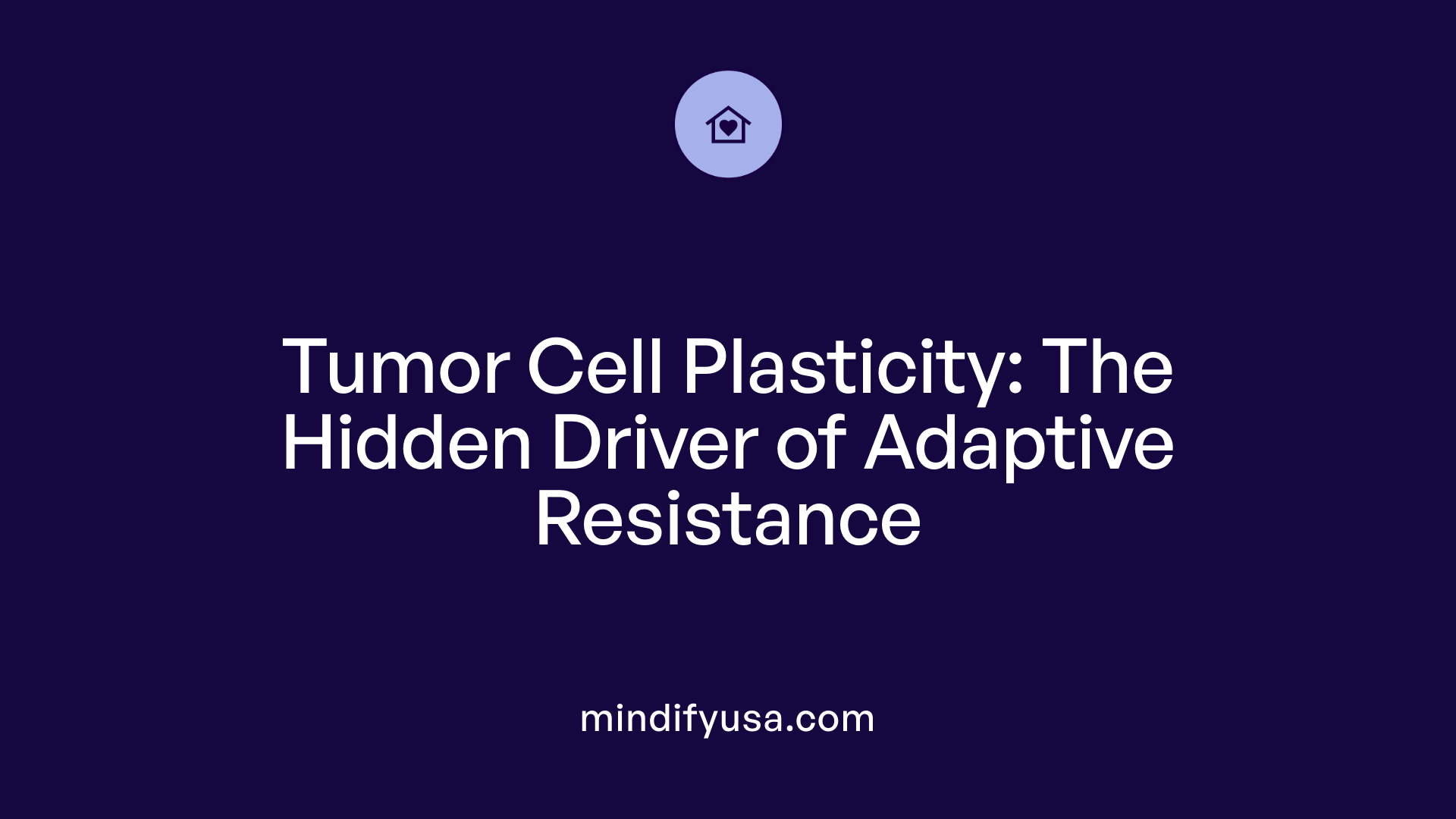
How does tumor cell plasticity contribute to adaptive resistance in adult cancers?
Tumor cell plasticity is a crucial player in the development of adaptive resistance in adult cancers. It refers to the ability of cancer cells to dynamically alter their phenotype in response to environmental cues and therapeutic pressures. This flexibility allows cancer cells to evade damage from targeted therapies and other treatment modalities.
One of the primary mechanisms behind this plasticity is epithelial-to-mesenchymal transition (EMT). During EMT, epithelial cells acquire mesenchymal traits, increasing motility and invasion capabilities while reducing dependency on specific epithelial markers. This transition grants tumor cells the ability to resist therapies aimed at epithelial features and enhances their metastatic potential.
Epigenetic regulation plays a significant role in facilitating plasticity. Modifications such as DNA methylation and histone alterations can activate or repress gene expression programs responsible for phenotypic shifts. Epigenetic flexibility enables cancer cells to transiently or permanently adapt their behavior without requiring genetic mutations.
Metabolic reprogramming is another aspect of plasticity. Cancer cells can switch between metabolic pathways—such as shifting from glycolysis to oxidative phosphorylation—to survive in hostile environments and resist drugs targeting specific metabolic processes. Alterations in energy production support their survival and growth despite therapy.
The tumor microenvironment heavily influences plasticity through complex interactions involving cytokines, growth factors, and extracellular matrix components. These external signals activate pathways like TGF-β, Wnt, and Notch, which govern lineage switching, stemness traits, and resistance mechanisms.
Cancer stem cells (CSCs) contribute significantly to tumor plasticity. They possess the ability to self-renew and differentiate into diverse cell types, enabling tumors to adapt and recover from therapies. CSCs often exhibit high levels of drug efflux transporters and anti-apoptotic proteins, granting them resilience.
Furthermore, the capacity for lineage transdifferentiation allows tumor cells to switch between different cellular identities, diminishing their dependence on targeted pathways. This phenotypic diversity complicates treatment strategies and paves the way for tumor relapse.
Signaling pathways such as TGF-β, Wnt/β-catenin, Notch, and NF-κB are central to mediating plasticity. Their activation supports EMT, stemness, and survival strategies, promoting resistance. These pathways are often upregulated or reactivated in resistant tumors.
In summary, tumor cell plasticity enhances the ability of cancer cells to survive various therapeutic insults. By continuously reshaping their phenotype—through EMT, epigenetic modifications, metabolic shifts, and microenvironmental influences—these cells sustain heterogeneity within tumors. This adaptability underpins both intrinsic resistance—present before treatment—and acquired resistance, which develops during therapy, ultimately leading to tumor progression and relapse.
Influence of the Tumor Microenvironment and CAFs
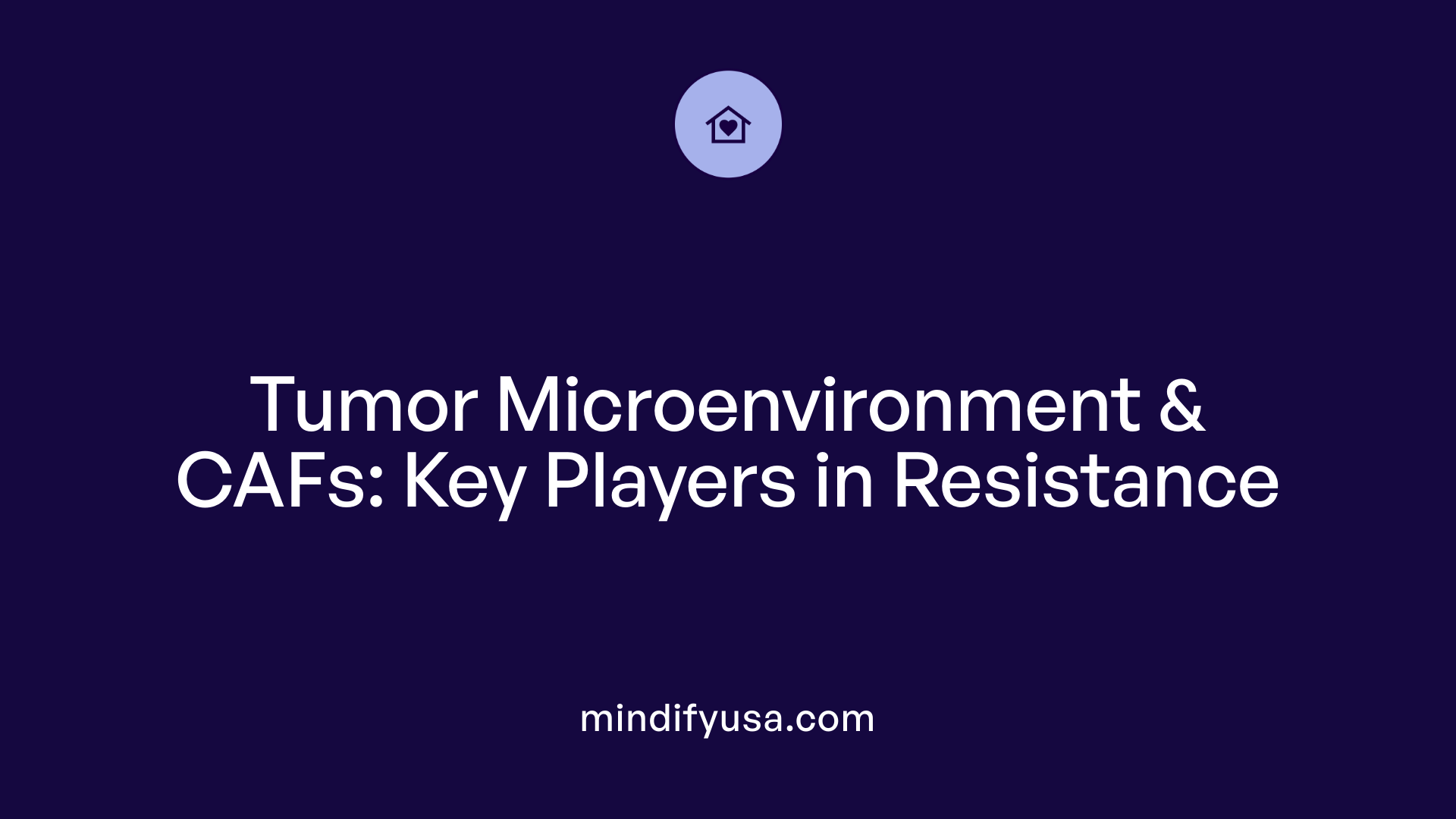
How does the tumor microenvironment, including cancer-associated fibroblasts (CAFs), influence therapy resistance?
The tumor microenvironment (TME) is a complex network of cellular and extracellular components that actively support cancer growth and resistance to treatments. Among its key players are cancer-associated fibroblasts (CAFs), which are highly heterogenous and consist of various subtypes such as myCAFs, iCAFs, and apCAFs. Each subtype has distinct roles in modifying the TME and promoting resistance.
CAFs secrete a variety of cytokines and growth factors, including transforming growth factor-beta (TGF-β), vascular endothelial growth factor (VEGF), and fibroblast growth factor 2 (FGF2). These molecules contribute to remodeling the extracellular matrix (ECM), resulting in increased tissue stiffness and creating physical barriers that hinder efficient drug penetration. Moreover, CAFs produce enzymes that modify ECM components, further affecting tumor architecture and therapy accessibility.
Exosomes released by CAFs and tumor cells serve as carriers of non-coding RNAs, proteins, and other molecular cargo. These vesicles facilitate communication between cells, enabling the horizontal transfer of drug resistance proteins and regulatory RNAs that support survival pathways and cancer stem cell maintenance. This intercellular exchange plays a critical role in adapting tumor cells to hostile environments, including chemotherapy and targeted therapy challenges.
In addition to physical and molecular support, CAFs influence immune responses within the TME. They secrete immunosuppressive cytokines such as IL-10 and TGF-β, which hinder effective immune cell infiltration and function. This creates an immunosuppressive niche that assists tumor cells in evading immune surveillance. CAFs also promote immune checkpoint activation, increasing the expression of proteins like PD-L1 on tumor and immune cells, thereby dampening anti-tumor immune responses.
Furthermore, the TME often becomes hypoxic and acidic, conditions that favor immune suppression and select for more resistant tumor cell populations. These environmental changes impair the efficacy of immunotherapies, such as checkpoint inhibitors, and contribute to overall therapy resistance.
CAF heterogeneity and subtypes
The different CAF subtypes have specific roles:
| CAF Subtype | Role | Impact on Resistance |
|---|---|---|
| myCAFs | Contractile, ECM producing | Enhance fibrosis, physical barriers |
| iCAFs | Cytokine secreting | Promote inflammation and survival pathways |
| apCAFs | Antigen presenting | Modulate immune responses |
Secretion of cytokines and remodeling of ECM
CAF-derived cytokines aid in tumor invasiveness and angiogenesis. ECM remodeling increases tissue density, making drug delivery more difficult and fostering a protective niche.
Exosome-mediated communication
Exosomes transfer content that can activate survival pathways, confer drug resistance, and support cancer stemness, reinforcing resistant phenotypes.
Immune evasion and checkpoints
CAFs contribute to immune escape by secreting cytokines that suppress effector immune cells and by upregulating immune checkpoints such as PD-L1, which inhibit T-cell function.
In summary, the TME and CAFs actively modify tumor behavior through diverse mechanisms. These interactions create an environment conducive to therapy resistance, posing significant challenges but also presenting potential therapeutic targets to disrupt these support systems.
Emerging Therapeutic Strategies and Advanced Treatments

What are the emerging therapeutic strategies and advanced treatment modalities, including immunotherapy and combination therapies, to overcome cancer resistance?
Recent advances in cancer treatment focus on overcoming the complex mechanisms that cause therapy resistance. One promising approach involves the development of targeted therapies such as antibody-drug conjugates (ADCs), which combine specific antibodies with potent drugs to selectively attack cancer cells. Novel tyrosine kinase inhibitors (TKIs) have been engineered to target mutations that confer resistance, like the EGFR T790M mutation in lung cancer.
In addition, inhibitors targeting crucial intracellular signaling pathways, including PI3K/AKT/mTOR and CDK4/6, are being explored to disrupt pathways that drive cell survival and proliferation despite treatment.
Immunotherapy has become a vital part of overcoming resistance, with strategies such as cancer vaccines, chimeric antigen receptor (CAR) T-cell therapy, and immune checkpoint inhibitors leading this space. These approaches aim to activate the immune system to recognize and destroy resistant cancer cells. Although checkpoint inhibitors like PD-1/PD-L1 blockers have shown limited success in certain tumors like pancreatic cancer due to an immunosuppressive microenvironment, ongoing research strives to enhance their efficacy.
Combining therapies is another key strategy. For example, pairing anti-HER2 antibodies with agents like pertuzumab or T-DM1 helps to bypass or inhibit resistance pathways. Multi-modal treatments aim to target different resistance mechanisms simultaneously, improving overall response rates.
Nanotechnology-based delivery systems are also emerging, offering the ability to precisely deliver drugs and reduce systemic toxicity. These nanotherapies can enhance drug accumulation within tumors, particularly in resistant microenvironments.
Furthermore, targeting and modulating components of the tumor microenvironment—such as cancer-associated fibroblasts (CAFs), extracellular matrix, and immune cells—are crucial. By disrupting the supportive niche that fosters resistance, these strategies aim to render tumors more susceptible to existing therapies.
In summary, a multifaceted approach incorporating advanced targeted agents, immunotherapies, combination strategies, nanotechnology, and microenvironment modulation holds the potential to significantly improve outcomes for patients facing resistant cancers.
Innovations in Research and Clinical Trials on Drug Resistance

What are the latest insights from research and clinical trials on overcoming drug resistance in cancer treatment?
Recent advancements in cancer research have significantly shifted towards understanding and combating therapy resistance. Cutting-edge studies are exploring the genetic and molecular mechanisms behind resistance, leading to the development of more precise targeted therapies.
One of the forefront areas is the application of genomic technologies, including next-generation sequencing and liquid biopsies. These tools allow real-time monitoring of tumor evolution, detection of resistance mutations such as EGFR T790M in lung cancer, and identification of actionable alterations. Liquid biopsies provide minimally invasive options for dynamic assessment of tumor heterogeneity, enabling tailored treatment adaptations.
In parallel, novel targeted agents and combination regimens are in development. For example, drugs like MM-151 and Sym004 are designed to overcome resistance mutations in the EGFR pathway by binding different epitopes or promoting receptor degradation. Additionally, inhibitors such as aveaumatinib and defactinib are being evaluated to disrupt KRAS-related signaling, a common resistance mechanism especially in pancreatic and colorectal cancers.
Preclinical studies have demonstrated promising results. Agents targeting polyploid giant cancer cells with mifepristone could eliminate a resistant cell population responsible for relapse. Moreover, emerging therapies like Tri-CAP, a physical plasma-based treatment, exhibit potential in selectively inducing apoptosis in resistant cells.
Early clinical trials are supplementing these findings. The RAMP 205 study, for instance, assesses the safety and efficacy of these innovative strategies in pancreatic cancer patients. Other trials are examining combinations of immune checkpoint inhibitors with targeted therapies to overcome the immunosuppressive tumor microenvironment.
Integrating advanced molecular profiling with these novel agents facilitates a more personalized approach, aiming to preempt or counteract resistance mechanisms.
Future directions and challenges
Despite these promising developments, challenges remain. Tumor heterogeneity can lead to multiple, concurrent resistance pathways. Ensuring the safety and tolerability of combination regimens, along with identifying the most effective sequences of therapy, is complex. Overcoming these hurdles requires ongoing clinical trials and interdisciplinary research.
In conclusion, the future of overcoming drug resistance lies in the integration of comprehensive molecular diagnostics with innovative treatment strategies. Continued progress in this arena offers hope for more durable responses and improved survival outcomes in adult cancer patients.
Challenges and Solutions in Managing Resistance Across Cancer Types

What are the specific challenges and potential solutions in managing therapy resistance across various cancers, including pancreatic, lung, leukemia, AML, MDS, and gastrointestinal cancers?
Managing resistance to cancer therapies presents significant challenges across different cancer types such as pancreatic adenocarcinoma (PDAC), lung cancer, leukemia, acute myeloid leukemia (AML), myelodysplastic syndromes (MDS), and gastrointestinal (GI) cancers. These challenges stem from the complex biological systems that tumors exploit to evade treatments.
One major obstacle is tumor heterogeneity. Tumors consist of diverse cell populations with distinct genetic and epigenetic profiles, enabling some cells to survive targeted therapies. For example, genetic mutations in pathways like EGFR in lung cancer or KRAS in pancreatic cancer can lead to resistance. Similarly, tumor microenvironment components, such as cancer-associated fibroblasts (CAFs), immune cells, and extracellular matrix (ECM), shield tumor cells and promote survival.
Cancer stem cells (CSCs) are another key factor. These cells possess self-renewal capabilities and often resist conventional therapy, fueling relapse and progression. Pathways like Wnt/β-catenin, Hedgehog, and Notch regulate CSC maintenance and are often upregulated in resistant cancer cells.
Additionally, processes like epithelial-to-mesenchymal transition (EMT) contribute to metastasis and resistance by increasing tumor cell mobility and drug efflux. The tumor microenvironment often produces immunosuppressive factors, such as adenosine, or recruits immune cells that inhibit anti-tumor immunity, making immunotherapy less effective.
Strategies to tackle these resistance mechanisms have evolved. Targeted therapies, such as inhibitors against specific mutations like EGFR T790M in lung cancer, are tailored to counteract known resistance pathways. For example, third-generation EGFR inhibitors and combination therapies targeting multiple pathways are improving response durability.
Efforts are also focused on modulating the tumor microenvironment. For instance, inhibiting CAF subtypes or signaling pathways like TGFβ and SHH can diminish stromal protection. Immune checkpoint inhibitors, although initially limited in pancreatic and GI cancers, are being refined to better overcome the immunosuppressive microenvironment.
Advances in nanotechnology and gene editing craft new opportunities for more precise delivery of drugs and genetic correction of resistance-causing mutations. Personalized medicine approaches, including the use of tumor organoids and microfluidic models, allow testing of tailored treatment regimens to overcome resistance.
Despite these promising approaches, translating them into widespread clinical practice is complex and requires extensive clinical trials. The multifactorial nature of resistance demands combination therapies that can simultaneously target multiple mechanisms. Ongoing research focuses on identifying novel resistance pathways and developing agents that can effectively and safely block them.
In summary, overcoming therapy resistance in various cancers requires a multifaceted strategy: understanding tumor biology deeply, designing targeted and combination therapies, and leveraging innovative technologies. Continued research and clinical trials are essential to translate these solutions into improved patient outcomes.
Importance of Understanding Resistance for Personalized Treatment

Why is understanding resistance mechanisms important for developing personalized and effective cancer treatments?
Cancer resistance to therapy is a complex challenge that directly affects treatment success and patient outcomes. It can arise from a multitude of factors, including genetic mutations, epigenetic modifications, and influences from the tumor microenvironment.
Genetic changes such as mutations in target genes (e.g., EGFR T790M mutation in lung cancer) can render therapies ineffective. Epigenetic alterations, like DNA methylation or histone modifications, can suppress tumor suppressor genes or activate resistance-related genes, making tumors more resilient against treatments. Additionally, the tumor microenvironment—comprising stromal cells, immune cells, extracellular matrix components, and secreted factors—can promote survival pathways and shield cancer cells from therapeutic agents.
To effectively combat resistance, advanced molecular diagnostics and genotyping are pivotal. These tools enable clinicians to identify specific genetic mutations, pathway activations, or phenotypic changes at the molecular level. Techniques such as liquid biopsies analyzing circulating tumor DNA (ctDNA) for mutations like T790M or other alterations allow real-time monitoring of tumor evolution.
Personalized and adaptive treatment strategies leverage this detailed molecular information. Tailoring therapies based on an individual’s tumor profile helps in selecting the most effective drugs, combinations, and sequences, thereby maximizing efficacy. For response adaptation, continuous monitoring allows adjustments to treatment plans, addressing emerging resistance mechanisms promptly.
This approach often involves combining targeted agents, immunotherapies, and even metabolic or microenvironmental modulators. It aims to preempt resistance development or overcome existing resistance by disrupting specific pathways or cellular processes responsible for it.
Understanding resistance at the molecular and cellular levels facilitates the design of precision medicine. It transforms the traditional 'one-size-fits-all' approach into a dynamic, patient-specific treatment plan that adapts over time. Ultimately, such insights significantly improve treatment success rates, reduce unnecessary toxicity, and extend survival.
By integrating comprehensive molecular diagnostics into clinical decision-making, clinicians can better predict resistance patterns and craft therapies that are truly personalized. This approach represents the future of oncology, offering hope for overcoming one of the biggest hurdles in cancer treatment—therapy resistance.
Summary and Future Directions

How can an integrated understanding of resistance mechanisms improve therapy outcomes?
Overcoming therapy resistance requires a comprehensive approach that understands the complex web of mechanisms cancer cells use to survive treatment. Resistance involves genetic mutations, tumor heterogeneity, microenvironment influences like CAFs and immune cells, metabolic reprogramming, and evasion strategies such as EMT and drug efflux. By integrating insights from these areas, researchers can identify common pathways or vulnerabilities, leading to the development of multi-targeted therapies that prevent cancer cells from bypassing treatment.
What are the promising innovative therapies and ongoing clinical trials in resistance management?
Recent advances include inhibitors targeting molecular pathways like KRAS, MYC, and OPA1, as well as immune checkpoint inhibitors tailored to modulate the tumor microenvironment. Emerging therapies such as cancer vaccines, nanoparticle drug delivery systems, and combination regimens that inhibit multiple pathways simultaneously are showing promise, particularly in preclinical models and early-phase trials. For example, combination therapies targeting MAPK reactivation in BRAF-mutated cancers have demonstrated improved outcomes.
How is personalization shaping future strategies against resistance?
Personalized medicine stands at the forefront of overcoming resistance. Techniques like liquid biopsies detect circulating tumor DNA, allowing real-time monitoring of resistance mutations such as EGFR T790M in lung cancer. The use of patient-derived organoids and microfluidic models enables testing of tailored drug combinations, optimizing treatment efficacy while minimizing toxicity. Molecular profiling helps identify specific resistance pathways and cancer stem cell signatures, guiding targeted interventions that are more likely to succeed.
What’s the outlook for the future of overcoming therapy resistance in adult cancers?
The future points toward precision oncology becoming more sophisticated with integrating genomic, proteomic, and microenvironmental data. Combining targeted therapies with immune-modulating agents and metabolic inhibitors to counteract tumor adaptations appears promising. Novel agents like Tri-CAP, which disrupt multiple survival pathways in resistant cells, highlight the potential of multi-mechanism interventions. Ongoing clinical trials continue to refine these strategies, aiming to turn resistance from an obstacle into a manageable aspect of cancer treatment.
How can this comprehensive approach translate into better patient outcomes?
Personalized, multi-arm therapy regimens tailored to individual tumor resistance profiles are expected to improve response rates and durability of remission. By targeting cancer stem cells, microenvironmental factors, and molecular pathways simultaneously, clinicians can prevent relapse and metastasis. This approach also fosters the development of less toxic organic compounds and innovative delivery systems, increasing the safety and quality of life for adult cancer patients.
| Future Directions | Focus Areas | Emerging Strategies | Expected Benefits |
|---|---|---|---|
| Integrated resistance mapping | Multi-level resistance mechanisms | Multi-targeted drugs, nanotechnology | Improved efficacy, reduced relapse |
| Advanced molecular diagnostics | Personalized treatment | Liquid biopsies, organoid testing | Faster adaptation to resistance |
| Combination therapies | Synergistic targeting | Pathway inhibitors plus immunotherapy | Durable responses, fewer side effects |
| New agents and pathways | Novel molecular targets | Tri-CAP, OPA1 inhibitors | Overcoming multi-drug resistance |
By advancing these areas, researchers and clinicians are paving the way towards a future where resistance is not an insurmountable barrier but a manageable challenge, turning cancer into a more treatable and survivable disease.
Transforming Cancer Therapy Through Resistance Research
Advances in understanding the molecular, cellular, and microenvironmental mechanisms of resistance are paving the way for innovative therapies and personalized approaches. Continued research, integration of cutting-edge diagnostics, and targeted interventions will be critical in overcoming therapy resistance, ultimately leading to improved survival and quality of life for adult cancer patients.
References
- Overcoming therapy resistance in pancreatic cancer: New insights ...
- Overcoming therapy resistance in EGFR-mutant lung cancer - PubMed
- Targeting cancer stem cells for reversing therapy resistance - Nature
- Unveiling the mechanisms and challenges of cancer drug resistance
- Strategic Combinations to Prevent and Overcome Resistance to ...
- New Strategies in Overcoming Acquired Resistance to Epidermal ...
- Overcoming cancer treatment resistance: Unraveling the role of ...
- Trident cold atmospheric plasma blocks three cancer survival ...
- Mechanisms of resistance to tyrosine kinase inhibitor‐targeted ...
- Novel Holistic Approaches for Overcoming Therapy Resistance in ...












